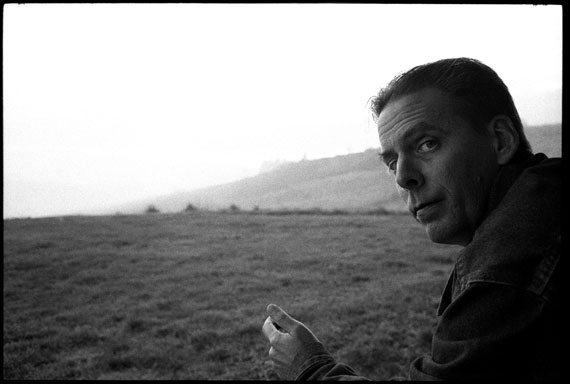
Peter Garland at Santa Fe New Music
Composer Peter Garland had traveled so many years in Guatemala, Bali, Java, Australia, the Philippines, and for a significant time in Mexico, “hanging out,” as he said, ” in places where most people dont even have cell phones,” that when he returned to the United States he saw himself a kind of “Rip Van Winkle,” rubbing his eyes awake after the dot com revolution to an accelerated cyber-nation. He heard perky banalities and a hundred snappy acronyms. Brand names arching from one side of the continent through another by way of every river town, border town, urban town and hometown.
Whats a composer to do? ” War of the Words, (Bringing Home the Tropes)” proved a good start at Stieren Hall November 11th. Garlands rousing piece of high cultural crankiness for two voices, sandals, clogs, beer glasses, metal pipes and spoons, presented as part of the Santa Fe New Music Program, took irreverent measure of the ups and downloads of the country. For the latter part of the program, fortunately, Garland evoked more lyrical affirmations as well.
War of the Words is visual, hectic, kinetic: a circus act, a poetry slam. Two vocalists behind a table slipped their hands into sandals and clogs, and while generating a mad Mexican hat dance on the table, shouted in unison “OPEN UP! Its the 1 23!” In the ensuing rhythmically complex duet, the CIA, FBI, GOP, NRA and the like were introduced in incessant rants and rhymes – part boot camp drill, part college cheerlead.
The players also faced each other, riffing with metal pipes, like frenetic figures rapping out not a sequence of hours but of Internet titans: “Google versus Yahoo!” or the ” Intels” who make the hardware. Thanks to the “found instruments” gathered from his travel and memory of Mexico, Garlands composition clamors and mugs with political irreverence. Spirits of mestizo, Zapotecas, urbanites of D.F. accompany with everyday instruments the imperious superficiality of El Norte. In the final sequence the musicians sipped Bud Light, then poured the brew into large, vase shaped glasses. The sounds recalled Garland’s days sipping café con leche in Veracruz amidst ” a virtual concert of glass-tapings.” The vocalists spun out in a break-neck parallel, one mechanically issuing the color of terrorist alerts, the other shouting a vast litany of American brands synonymous with hunger: ” Whopper, Big Mac, Hungry Man!!”
Though rife with comic conceit, the score demands great expertise. It is a sharply composed arrhythmia. Contrapuntal Love Songsloops, upbeats, rests, demand the erratic and straight-ahead business of perfect time-keeping. The irony of the punch line lies, of course, in Garlands transformation of the whole insipid lexicon he laments into a work of (anti) art.
Making ruckus of his (own) culture shocks, the 58-year-old composer — friend and protegé of Lou Harrison, John Cage and Harry Partch — reminds himself of a man who, when “brought before the King, promptly drops his pants and takes a big shit!” Purged (limitedly), Garland can “now return to the real work, which is Beauty.”
With “Coyotes Bones (Last Piece)” from the Love Songs album, two short meditations dedicated to the percussionist William Winat and instrument maker William Coldwig, Garland indeed returned to spare, graceful pleasure. While ” Beauty” by the name alone incites suspicious lobby debates during intermission, give Garland a piano, marimba, a violin, the remembered inflections of Bali and Indonesian Gamelan, errant pretty 7th chords, and trust the way he stays close to emptiness. That, to my mind, puts the questions aside.
But for this one. As an ensemble the three performers sounded less then tightly rehearsed: entrances were loose, rhythmic figures requiring an easy exactitude between instruments, wobbly. Beauty there was, but without precision “Coyotes Bones” could be lethargic rather then meditative, insecure instead of eccentric.
The most ambitious and arguably most important work of the night, “The Roque Dalton Songs,” Garlands song cycle based on the writings of Salvadorean poet and guerilla activist, Roque Dalton, brought into the same moment of time the delicacy of harp and the bullets of a firing squad. Drums and clapboards literalized thrombing rifles and pounding hearts, Perfectly synchronized patterns ritualized the approach to the executioners wall.
As the piece began I suspected that Garlands score was outmatched by the scale of Daltons historical dramas. But the music held before the poetrys violent intimacies and never overreached into sentimentality but stayed a conjured speech of nightmare prayer. And the very capable tenor John Duykers did what he could do with the vocal score but needed different direction in that, with Garlands music here so inherently narrative, Garlands tenor would seem to belong more with the campesino, the singer of Mexican rancheras who ” holds up his dying heart,” as Alma Guillermoprieto has written.
In this one regard Garland betrayed his own instrumentation – in mistaking the part he needed to cast for one schooled in opera or German lieder, clashing the bourgeois vocal tradition uncomfortably in the performance hall with the visionary blooms and guns of Daltons struggle. Had the poems been plainly recited at intervals, the work would have been more fully at home with itself. Seed, gourd and hide, wood, horsehair and copper wire – Garlands most resonant technology – would have been music enough.
